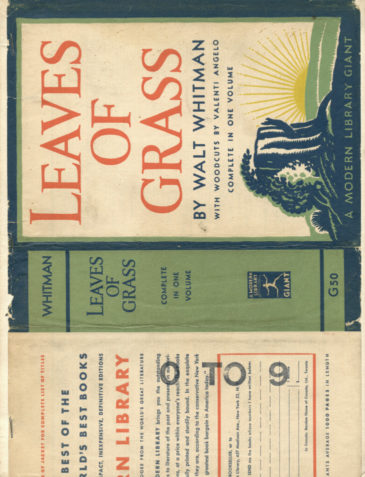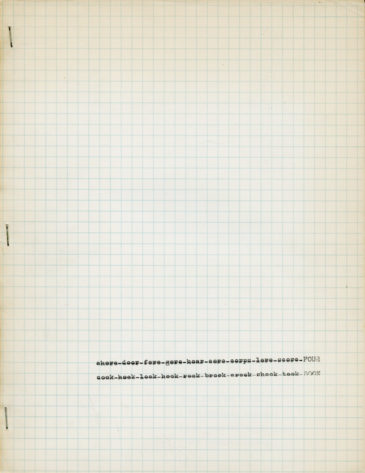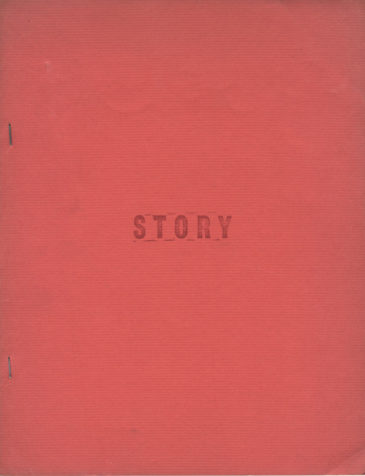0 to 9
Bernadette Mayer and Vito Hannibal Acconci
New York
Nos. 1–6 (April 1967–July 1969), and Supplement to No. 6, entitled Street Works (1969).
0 to 9 4 (1968).

“What is a body artist? Someone who is his own test tube,” quips painter David Salle about performance artist, filmmaker, and writer Vito Hannibal Acconci, probably the prime example of an artist who experiments on himself and his own life, using his body and its movements as his materia artistica. Born in New York City in 1940, Acconci returned to the Lower East Side in 1964 to teach at Brooklyn College and the School of Visual Arts after graduating from Holy Cross College and the Iowa Writers’ Workshop. Acconci was first a writer, and with his sister-in-law, Bernadette Mayer, edited one of the most experimental of all the early mimeo magazines. 0 to 9 included works by a phalanx of literary experimentalists, including the minimalist works of Aram Saroyan and Clark Coolidge, along with the graphic works of artists Sol LeWitt, Michael Heizer, and Robert Smithson, and performance-oriented work by Jackson Mac Low, Steve Paxton, and Acconci himself.
Art historian Kate Linker places Acconci’s earliest language-oriented work as a poet, including 0 to 9, in the perspective of his later accomplishments: “Zeroing in on or ‘targeting’ language, the works attempt to materialize language, to give words body and weight—substance but not depth. Throughout the pieces, language points to itself, reflexively describing its motion over the page along with its capacities for accumulation, juxtaposition, and interplay. These early poems comprise a series of ruthlessly logical operations on poetic space. Although the literalism of the language indicates an assault on the ‘expressive’ author or self, the poems reinforce the modernist prescription to acknowledge the limits of the medium. They renounce language’s referential function, its ability to evoke a world off the page; instead their aim, Acconci has written, was to ‘Use language to cover a space rather than uncover a meaning.’” In the tradition of little magazines of the 1960s, 0 to 9 published a supplement and several books in addition to the magazine.
In “A Lecture at the Naropa Institute, 1989,” Poetics Journal (1990), Bernadette Mayer discusses the conception and structure of Story:
“This is the first book I ever published. I published it myself. It’s called Story. It has no page numbers. It’s about thirty pages. The way it came into being was I wrote a story that was about falling down, tripping and falling down. It was nicely written, experimentally so, but it seemed dull. So I tried to figure out what to do with it; and being a twenty-year-old person at the time, I went overboard and made a structure that is like a diamond shape where I accumulated other texts. I was very interested in American Indian myths at that time so I included a Kwakiutl myth about hats and about smoking; their description of a hoop and arrow game; and then an Italian folk tale about fourteen men who went to hell; another Italian tale about a man who sold cloth to a statue; then from Coos myth texts, a story of the five world makers, and the man who became an owl. Then I accumulated some lists from the dictionary of other words for beginning, middle and end. There’s a recipe for true sponge cake, there’s a 19th-century letter about etiquette, a couple of quotes from Edgar Allan Poe, and an article by the biologist Louis Agassiz about coral reefs.
Each of these things I thought was relevant to the diamond-shaped nature or accumulation of the story…. As I was saying to Clark Coolidge, there is some aspect of this work that I can’t remember (as to how I did it). I took the longest work which was the story I’d written about falling, and I made that begin at the beginning and end at the end. Everything was going on in the exact middle of the work, and at the beginning and end only one thing was going on and it was gradually accumulating and decreasing. To make things worse, I decided to interrupt the text at random moments with all the words I could think of that would mean story…. There are fifty-one…anecdote, profile, life-story, scenario, love-story, lie, report, western, article, bedside reading, novel, thumbnail sketch, talk, description, real-life story, piece, light reading, confessions, dime novel, narrative poem, myth, thriller. It was interrupted at random. The confluences were amazing. All of a sudden it would say detective story, and the section that was randomly chosen to be a detective story really became one. Or could become one in the reader’s mind. Probably more so than in my mind.”
0 to 9 Books (complete)
Acconci, Vito Hannibal. Book / Transference: Roget’s Thesaurus. 1969.
Acconci, Vito Hannibal. Four Book. 1968.
Mayer, Bernadette. Story. 1968.
Mayer, Rosemary. Book: 41 Fabric Swatches. 1969.
Piper, Adrian. Three untitled booklets. 1968.
Saroyan, Aram. Coffee Coffee. 1967.

Vito Hannibal Acconci, Four Book (1968).

Bernadette Mayer, Story (1968).
